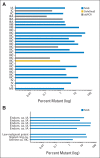Lavage of the Uterine Cavity for Molecular Detection of Müllerian Duct Carcinomas: A Proof-of-Concept Study
- PMID: 26552420
- PMCID: PMC4678180
- DOI: 10.1200/JCO.2015.61.3083
Lavage of the Uterine Cavity for Molecular Detection of Müllerian Duct Carcinomas: A Proof-of-Concept Study
Abstract
Purpose: Type II ovarian cancer (OC) and endometrial cancer (EC) are generally diagnosed at an advanced stage, translating into a poor survival rate. There is increasing evidence that Müllerian duct cancers may exfoliate cells. We have established an approach for lavage of the uterine cavity to detect shed cancer cells.
Patients and methods: Lavage of the uterine cavity was used to obtain samples from 65 patients, including 30 with OC, five with EC, three with other malignancies, and 27 with benign lesions involving gynecologic organs. These samples, as well as corresponding tumor tissue, were examined for the presence of somatic mutations using massively parallel sequencing (next-generation sequencing) and, in a subset, singleplex analysis.
Results: The lavage technique could be applied successfully, and sufficient amounts of DNA were obtained in all patients. Mutations, mainly in TP53, were identified in 18 (60%) of 30 lavage samples of patients with OC using next-generation sequencing. Singleplex analysis of mutations previously determined in corresponding tumor tissue led to further identification of six patients. Taken together, in 24 (80%) of 30 patients with OC, specific mutations could be identified. This also included one patient with occult OC. All five analyzed lavage specimens from patients with EC harbored mutations. Eight (29.6%) of 27 patients with benign lesions tested positive for mutations, six (75%) as a result of mutations in the KRAS gene.
Conclusion: This study proved that tumor cells from ovarian neoplasms are shed and can be collected via lavage of the uterine cavity. Detection of OC and EC and even clinically occult OC was achieved, making it a potential tool of significant promise for early diagnosis.
© 2015 by American Society of Clinical Oncology.
Conflict of interest statement
Authors' disclosures of potential conflicts of interest are found in the article online at
Figures



Similar articles
-
Cervicovaginal specimen biomarkers for early detection of ovarian and endometrial cancer: A review.Cancer Med. 2024 Jul;13(14):e70000. doi: 10.1002/cam4.70000. Cancer Med. 2024. PMID: 39031958 Free PMC article. Review.
-
Towards less invasive molecular diagnostics for endometrial cancer: massively parallel sequencing of endometrial lavage specimens in women attending for an office hysteroscopy.J Mol Med (Berl). 2022 Sep;100(9):1331-1339. doi: 10.1007/s00109-022-02239-7. Epub 2022 Aug 12. J Mol Med (Berl). 2022. PMID: 35953603
-
Genomic Analysis of Uterine Lavage Fluid Detects Early Endometrial Cancers and Reveals a Prevalent Landscape of Driver Mutations in Women without Histopathologic Evidence of Cancer: A Prospective Cross-Sectional Study.PLoS Med. 2016 Dec 27;13(12):e1002206. doi: 10.1371/journal.pmed.1002206. eCollection 2016 Dec. PLoS Med. 2016. PMID: 28027320 Free PMC article.
-
Uterine Cavity Lavage Mutation Analysis in Lithuanian Ovarian Cancer Patients.Cancers (Basel). 2023 Jan 30;15(3):868. doi: 10.3390/cancers15030868. Cancers (Basel). 2023. PMID: 36765826 Free PMC article.
-
[Ovarian cancer--modern approach to its origin and histogenesis].Ginekol Pol. 2012 Jun;83(6):454-7. Ginekol Pol. 2012. PMID: 22880466 Review. Polish.
Cited by
-
Feasibility and clinical applicability of genomic profiling based on cervical smear samples in patients with endometrial cancer.Front Oncol. 2022 Aug 5;12:942735. doi: 10.3389/fonc.2022.942735. eCollection 2022. Front Oncol. 2022. PMID: 35992873 Free PMC article.
-
RNA biomarkers from proximal liquid biopsy for diagnosis of ovarian cancer.Neoplasia. 2022 Feb;24(2):155-164. doi: 10.1016/j.neo.2021.12.008. Epub 2022 Jan 5. Neoplasia. 2022. PMID: 34998206 Free PMC article.
-
High-Grade Serous Ovarian Cancer-A Risk Factor Puzzle and Screening Fugitive.Biomedicines. 2024 Jan 19;12(1):229. doi: 10.3390/biomedicines12010229. Biomedicines. 2024. PMID: 38275400 Free PMC article. Review.
-
Cervicovaginal specimen biomarkers for early detection of ovarian and endometrial cancer: A review.Cancer Med. 2024 Jul;13(14):e70000. doi: 10.1002/cam4.70000. Cancer Med. 2024. PMID: 39031958 Free PMC article. Review.
-
Ultra-Sensitive TP53 Sequencing for Cancer Detection Reveals Progressive Clonal Selection in Normal Tissue over a Century of Human Lifespan.Cell Rep. 2019 Jul 2;28(1):132-144.e3. doi: 10.1016/j.celrep.2019.05.109. Cell Rep. 2019. PMID: 31269435 Free PMC article.
References
-
- Ferlay J, Parkin DM, Steliarova-Foucher E. Estimates of cancer incidence and mortality in Europe in 2008. Eur J Cancer. 2010;46:765–781. - PubMed
-
- Zorn KK, Bonome T, Gangi L, et al. Gene expression profiles of serous, endometrioid, and clear cell subtypes of ovarian and endometrial cancer. Clin Cancer Res. 2005;11:6422–6430. - PubMed
-
- Stirling D, Evans DG, Pichert G, et al. Screening for familial ovarian cancer: Failure of current protocols to detect ovarian cancer at an early stage according to the International Federation of Gynecology and Obstetrics system. J Clin Oncol. 2005;23:5588–5596. - PubMed
-
- American Cancer Society. Cancer Facts and Figures 2013. Atlanta, GA: American Cancer Society; 2013.
MeSH terms
Substances
Grants and funding
LinkOut - more resources
Full Text Sources
Other Literature Sources
Medical
Research Materials
Miscellaneous

